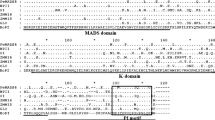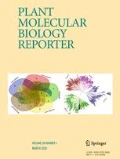Abstract
Very few flower organ identity genes have been characterized in Chinese narcissus (Narcissus tazetta var. chinensis), which has petaloid sepals. Here, we report the cloning of two full-length B-class genes, namely NAP3L3 and NAP3L4, that are orthologs of the DEFICIENS lineage. Both genes are highly expressed in the second whorl of the perianth and in the stamens. NAP3L4 is also expressed strongly in the ovule. The functions of these two genes were further analyzed using transgenic plants. Ectopic expression of either gene in Arabidopsis gave no obvious floral organ transformation phenotypes. In yeast two-hybrid assays, NAP3L3 and NAP3L4 failed to homodimerize and interacted weakly with each other. The data suggest that these two genes might not be involved in the formation of petaloid sepals. Isolation and functional analysis of other B-class paralogs should be conducted to fully understand petaloid tepal development in Chinese narcissus.





Similar content being viewed by others

Abbreviations
- DEF :
-
DEFICIENS
- AP3 :
-
APETALA3
- GLO :
-
GLOBOSA
- PI :
-
PISTILLATA
- TM6 :
-
TOMATO MADS BOX GENE6
- NAP3L :
-
Narcissus AP3-like
References
An YH, Li XF, Zhu JX, Shao XH, Sun Y, Xiong LJ (2007) The screening of interaction factors with BoCAL and BoAP1 related to curd formation. J Mol Cell Biol 40:130–136
Clough SJ, Bent AF (1998) Floral dip: a simplified method for Agrobacterium-mediated transformation of Arabidopsis thaliana. Plant J 16:735–743
Coen ES, Meyerowitz EM (1991) The war of the whorls: genetic interactions controlling flower development. Nature 353:31–37
Dahlgren RMT, Clifford HT, Yeo PF (eds) (1985) The families of the monocotyledons. Springer, Berlin
de Martino G, Pan I, Emmanuel E, Levy A, Irish VF (2006) Functional analyses of two tomato APETALA3 genes demonstrate diversification in their roles in regulating floral development. Plant Cell 18:1833–1845
Geuten K, Irish V (2010) Hidden variability of floral homeotic B genes in Solanaceae provides a molecular basis for the evolution of novel functions. Plant Cell 22:2562–2578
Geuten K, Viaene T, Irish VF (2011) Robustness and evolvability in the B-system of flower development. Ann Bot 107:1545–1556
Goto K, Meyerowitz EM (1994) Function and regulation of the Arabidopsis floral homeotic gene PISTILLATA. Genes Dev 8:1548–1560
Jack T, Fox GL, Meyerowitz EM (1994) Arabidopsis homeotic gene APETALA3 ectopic expression: transcriptional and posttranscriptional regulation determine floral organ identity. Cell 76:703–716
Kanno A, Saeki H, Kameya T, Saedler H, Theissen G (2003) Heterotopic expression of class B floral homeotic genes supports a modified ABC model for tulip (Tulipa gesneriana). Plant Mol Biol 52:831–841
Kanno A, Nakada M, Akita Y, Hirai M (2007) Class B gene expression and the modified ABC model in nongrass monocots. Sci World J 7:268–279
Kim S, Yoo MJ, Albert VA, Farris JS, Soltis PS, Soltis DE (2004) Phylogeny and diversification of B-function MADS-box genes in angiosperms: evolutionary and functional implications of a 260-million-year-old duplication. Am J Bot 91:2102–2118
Kramer EM, Irish VF (1999) Evolution of genetic mechanisms controlling petal development. Nature 399:144–148
Kramer EM, Dorit RL, Irish VF (1998) Molecular evolution of genes controlling petal and stamen development: duplication and divergence within the APETALA3 and PISTILLATA MADS-box gene lineages. Genetics 149:765–783
Kramer EM, Holappa L, Gould B, Jaramillo MA, Setnikov D, Santiago PM (2007) Elaboration of B gene function to include the identity of novel floral organs in the lower eudicot Aquilegia. Plant Cell 19:750–766
Krizek BA, Meyerowitz EM (1996) Mapping the protein regions responsible for the functional specificities of the Arabidopsis MADS domain organ-identity proteins. Proc Natl Acad Sci USA 93:4063–4070
Li R, Fan Y (2011) Molecular cloning and expression analysis of a terpene synthase gene, HcTPS2, in Hedychium coronarium. Plant Mol Biol Rep 29:35–42
Ludevid D, Hofte H, Himelblau E, Chrispeels MJ (1992) The expression pattern of the tonoplast intrinsic protein gamma-TIP in Arabidopsis thaliana is correlated with cell enlargement. Plant Physiol 100:1633–1639
Mockli N, Auerbach D (2004) Quantitative beta-galactosidase assay suitable for high-throughput applications in the yeast two-hybrid system. Biotechniques 36:872–876
Mondragon-Palomino M, Theissen G (2011) Conserved differential expression of paralogous DEFICIENS- and GLOBOSA-like MADS-box genes in the flowers of Orchidaceae: refining the ‘orchid code’. Plant J 66:1008–1019
Mondragon-Palomino M, Hiese L, Harter A, Koch MA, Theissen G (2009) Positive selection and ancient duplications in the evolution of class B floral homeotic genes of orchids and grasses. BMC Evol Biol 9:81
Munster T, Wingen LU, Faigl W, Werth S, Saedler H, Theissen G (2001) Characterization of three GLOBOSA-like MADS-box genes from maize: evidence for ancient paralogy in one class of floral homeotic B-function genes of grasses. Gene 262:1–13
Murashige T, Skoog F (1962) A revised medium for rapid growth and bioassays with tobacco tissue cultures. Physiol Plant 15:473–479
Park JH, Ishikawa Y, Yoshida R, Kanno A, Kameya T (2003) Expression of AODEF, a B-functional MADS-box gene, in stamens and inner tepals of the dioecious species Asparagus officinalis L. Plant Mol Biol 51:867–875
Park JH, Ishikawa Y, Ochiai T, Kanno A, Kameya T (2004) Two GLOBOSA-like genes are expressed in second and third whorls of homochlamydeous flowers in Asparagus officinalis L. Plant Cell Physiol 45:325–332
Poupin MJ, Federici F, Medina C, Matus JT, Timmermann T, Arce-Johnson P (2007) Isolation of the three grape sub-lineages of B-class MADS-box TM6, PISTILLATA and APETALA3 genes which are differentially expressed during flower and fruit development. Gene 404:10–24
Rijpkema AS, Royaert S, Zethof J, van der Weerden G, Gerats T, Vandenbussche M (2006) Analysis of the Petunia TM6 MADS box gene reveals functional divergence within the DEF/AP3 lineage. Plant Cell 18:1819–1832
Southerton SG, Marshall H, Mouradov A, Teasdale RD (1998) Eucalypt MADS-box genes expressed in developing flowers. Plant Physiol 118:365–372
Theissen G (2000) Evolutionary developmental genetics of floral symmetry: the revealing power of Linnaeus’ monstrous flower. BioEssays 22:209–213
Theissen G, Becker A, Di Rosa A, Kanno A, Kim JT, Munster T, Winter KU, Saedler H (2000) A short history of MADS-box genes in plants. Plant Mol Biol 42:115–149
Thompson JD, Higgins DG, Gibson TJ (1994) CLUSTAL W: improving the sensitivity of progressive multiple sequence alignment through sequence weighting, position-specific gap penalties and weight matrix choice. Nucleic Acids Res 22:4673–4680
Trobner W, Ramirez L, Motte P, Hue I, Huijser P, Lonnig WE, Saedler H, Sommer H, Schwarz-Sommer Z (1992) GLOBOSA: a homeotic gene which interacts with DEFICIENS in the control of Antirrhinum floral organogenesis. EMBO J 11:4693–4704
Tzeng TY, Yang CH (2001) A MADS box gene from lily (Lilium Longiflorum) is sufficient to generate dominant negative mutation by interacting with PISTILLATA (PI) in Arabidopsis thaliana. Plant Cell Physiol 42:1156–1168
Vandenbussche M, Theissen G, Van de Peer Y, Gerats T (2003) Structural diversification and neo-functionalization during floral MADS-box gene evolution by C-terminal frameshift mutations. Nucleic Acids Res 31:4401–4409
Vandenbussche M, Zethof J, Royaert S, Weterings K, Gerats T (2004) The duplicated B-class heterodimer model: whorl-specific effects and complex genetic interactions in Petunia hybrida flower development. Plant Cell 16:741–754
Weigel D, Meyerowitz EM (1994) The ABCs of floral homeotic genes. Cell 78:203–209
Wen Z, Gao M, Jiao C, Wang Q, Xu H, MonikaWalter XW, Bassett C, Wang X (2012) Characterization and expression analysis of a retinoblastoma-related gene from Chinese wild Vitis pseudoreticulata. Plant Mol Biol Rep 30:983–991
Winter KU, Weiser C, Kaufmann K, Bohne A, Kirchner C, Kanno A, Saedler H, Theissen G (2002) Evolution of class B floral homeotic proteins: obligate heterodimerization originated from homodimerization. Mol Biol Evol 19:587–596
Yu D, Kotilainen M, Pollanen E, Mehto M, Elomaa P, Helariutta Y, Albert VA, Teeri TH (1999) Organ identity genes and modified patterns of flower development in Gerbera hybrida (Asteraceae). Plant J 17:51–62
Zahn LM, Leebens-Mack J, DePamphilis CW, Ma H, Theissen G (2005) To B or Not to B a flower: the role of DEFICIENS and GLOBOSA orthologs in the evolution of the angiosperms. J Hered 96:225–240
Acknowledgments
This work was supported by the Shanghai Natural Science Program on Key Basic Research Project (grant 09JC1405100) and the Project of Science and Technology Support Xingjiang (grant 200840102-39). We are grateful to Dr. Sheila McCormick (Department of Plant and Microbial Biology, UC-Berkeley) and Dr. Weihua Tang (Institute of Plant Physiology and Ecology, SIBS, CAS) for critically reading the manuscript.
Author information
Authors and Affiliations
Corresponding author
Electronic supplementary material
Below is the link to the electronic supplementary material.
Supplementary Fig. 1
Phenotype of NAP3L3 and NAP3L4 overexpressing lines of the T0 generation. a, b Seedling of NAP3L3 over-expressing lines. c Seedling of NAP3L4 overexpressing line. d Seedling of Col. e Flowers of wild-type (Col) and NAP3L overexpressing lines. Bars a–d 3 mm, e 0.5 mm. (DOC 226 kb)
Rights and permissions
About this article
Cite this article
Li, XF., Xu, J., Yang, R. et al. Analysis of B-Class Genes NAP3L3 and NAP3L4 in Narcissus tazetta var. chinensis . Plant Mol Biol Rep 31, 255–263 (2013). https://doi.org/10.1007/s11105-012-0493-8
Published:
Issue Date:
DOI: https://doi.org/10.1007/s11105-012-0493-8



